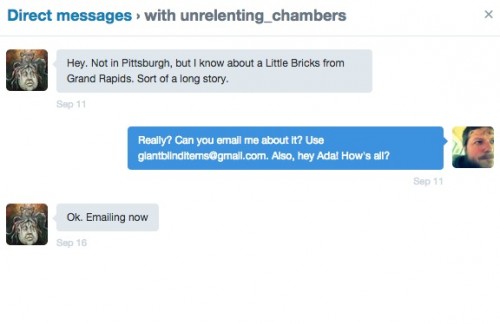Behind the Scenes
A Tagger Named Little Bricks

I swear this is true. It starts here:
Has anyone here ever heard of a Pennsylvania tagger who went by "Little Bricks?"
— Matthew Simmons (@matthewjsimmons) September 19, 2014
I went on to speculate that said tagger was probably based in Pittsburgh.
When I was a kid, we lived in Pittsburgh and sometimes my folks would bring my brother and me to the Kennywood amusement park.
So, sometimes I remember things—or, I guess what happens is I half remember things and want to remember the rest, so my brain does what it can to fill things in like the bastard that it is. I remember that at Kennywood, I became terrified when a “control your own altitude” plane ride in the part of the park for very little children went up beyond my tolerance. It was a modified carousel- or octopus-style ride with planes on armatures around a central axis and motor, and each plane had a stick that allowed the passengers to cause the arm to lift the plane off the ground. I was seated with another child—the planes accommodated two “pilots” each—a daredevil who grabbed the stick on the plane and pulled back, and up we went to a height that dizzied me. (I assume now that the distance between myself and the ground at the armature’s full extension was probably less than six feet. I was a tense, small child.) I screamed and my father got the operator to stop the ride so I could get off it. I still feel shame about this incident. I am in my 40s.
I am also, to this day, afraid of flying. Talk to me after a flight and you are talking to a man whose brain is warmly pulsing with alprazolam. A few years ago, I had a picture of Joe Kittinger, an American pilot who until recently held the record for longest skydive, tattooed on my arm in hopes that it would act as a barrier between myself and my fear of flying, but it has not worked. Things rarely work out as we want them to.
But I was on Kennywood.
My favorite ride at Kennywood was a train. Or not precisely a train. Cars, actually. On a wooden track. It was a long—or it seemed long to me—twisting track with cars on it. The riders powered the cars with their hands, turning a crank that turned the wheels. I hated that that ride had an end, hated that at some point a whistle blew and we all had to stop riding. The track was a one long loop and I always wanted to keep going. My folks would eventually have to pull me, protesting, off my car to take us home.
I was just learning to read at that time. At least, I remember myself as a person who was just learning to read at that time. Likely I was doing some directed reading, but not reading on my own. One night, being pulled from my car, grasping and struggling and tearing up, I looked back at my seat and saw words written on the plastic. I stopped crying and asked my dad what the words said. He said:
Little Bricks
*
I got the following response to that tweet.

Ada, a writer I sort of know through Twitter, wrote a couple of days later. Here is what she had to say:
“I grew up on a cul-de-sac in Grand Rapids. This was the mid-80s when all this happened. One morning, the house next door had some graffiti spray painted on the side of the house. ‘Little Bricks,’ it said. They washed it off that day. The next day, it was there again.
“Started happening to another house on the cul-de-sac. We would wake up. ‘Little Bricks.’ Two houses. Then three. Then it jumped the cul-de-sac. Started happening in the nearby blocks. Night fell. Wake up. ‘Little Bricks’ here and there.
“Spread a long ways. Lots of blocks. But only to certain houses.
“Know how some brick front houses have, I guess you’d call them ‘regular-sized bricks?’ And a smaller number of them—but still a bunch—have the ones that are a quarter of that size? ‘Little bricks’ on the front and sides of the houses? Those were the ones hit. Seems obvious, I guess. Still took us all a bit to figure it out. We had other things on our minds.
“Security lights didn’t help. ‘Little Bricks’ was tenacious. Homeowners would stay up all night waiting on ‘Little Bricks’ but never see anyone. ‘Little Bricks’ was ghostly. Within a month, it was a plague on Grand Rapids. ‘Little Bricks’ was infectious. It appeared in one sort of handwriting, one style, for the first few weeks. And then it began to mutate. ‘Little Bricks’ was unstoppable.
“Weirdest thing? Everyone pretty much knew who the culprit was. One of our neighbors had gone to the Neighborhood Watch—because, he said, he couldn’t figure out who else was the cul-de-sac’s governing authority—to complain when the first house with its little brick veneer appeared. The little bricks were all pretty knew and most were just a siding that had been used to replace a vinyl siding. People thought little bricks were classy. This guy hated them. Big bricks, he could accept. Little bricks, not so much. Property values. Community-agreed upon aesthetics. Symmetry to our domestic environs. A pleasurable block that we can all walk down without being jarred by an affronting facade.
“So he was clearly the one doing it. But no one ever caught him. And then ‘Little Bricks’ got away from him and multiplied through the hands of other graffiti writers. ‘Little Bricks’ left him. ‘Little Bricks’ flourished for two years. And then it just stopped.
“You’ll like this, because you like this sort of thing. The guy’s name was Andrew Coleman.”
*
I’m still working diligently to unearth the story of ‘60s psychedelic folk and early electronic music pioneer Adrianne Coleman. Goodness knows where I will write about it since HTML Giant is going away.
But Andrew Coleman is a name I have heard before, and Ada knows it. Mostly, I hear that Andrew Coleman was the brother of Adrianne Coleman. Andrew Coleman, from every mention I’ve discovered, was a cranky fixture at city council meetings in Grand Rapids from the mid-‘80s to the late ‘90s. Some transcripts can be found—Coleman, given two or three minutes, usually rants about noise pollution and the difficulty of recording “pure sounds” where he lives. How hard it is to finish his “project” what with the kids at play and screaming and the lawnmowers and the amateur mechanics revving the engines of their cars. “Please do something why won’t you do something.” No ones seems to do something. Or anything.
A timeline is hard to piece together here because so much of it happens before the internet started saving all our lives and memories for us, but Adrianne Coleman disappears when Andrew Coleman begins to appear. There is something there.
I do, Ada, like this sort of thing.
Perhaps this note should appear earlier in this piece, but I honestly don’t know what to make of the implications. My encounter with “Little Bricks” happened in the mid-’70s [late-’70s, see editing note below], many years before the graffiti appeared—and if Ada’s story is to be believed—originated in Grand Rapids, Michigan. Ada, I think, wouldn’t lie to me. So all this is true. I swear.
EDIT:
My mother kept fairly detailed calendars of our lives in the ’70s and ’80s. We have determined that my encounter with the “Little Bricks” tag very likely happened on our final visit to Kennywood before we moved to Kansas City. It would’ve been July 3, 1979. It was a Tuesday.
Tags: adrianne coleman, fear of flying, kennywood, little bricks, michigan, pittsburgh

i’m going to miss these posts.
My brother found an image of the cars at Kennywood.
https://www.facebook.com/191268807567517/photos/pb.191268807567517.-2207520000.1412706274./811214642239594/?type=3&theater
speaking of, did you know that my boyfriend knows your brother?
I did! I discovered this through Ello. The art world is apparently as small as the lit world.
this kicks ass
criticism: noise transmuted into aural graffiti, visual noise transmuted by graffiti